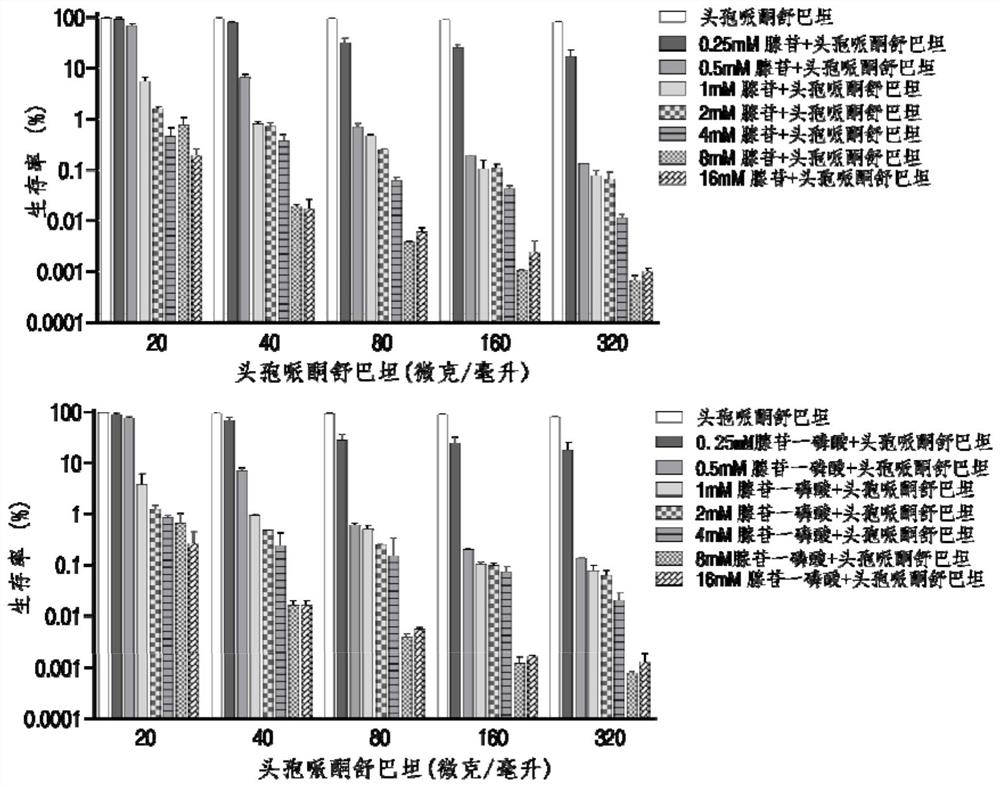Application of adenosine or adenosine monophosphate in preparation of anti-infective drugs
An adenosine monophosphate, anti-infection technology, applied in the field of biomedicine, can solve the problems of limited small molecules, unable to meet the needs of antibiotics and pathogenic bacteria, achieve good anti-infection effect, and reduce the effect of bacterial drug resistance
- Summary
- Abstract
- Description
- Claims
- Application Information
AI Technical Summary
Problems solved by technology
Method used
Image
Examples
Embodiment 1
[0034] Example 1 Bacterial Sample Preparation
[0035] Pick a single bacterial colony and inoculate it in 5 mL of LB medium, at 37°C (Escherichia coli, Klebsiella pneumoniae, Pseudomonas aeruginosa, Coccus faecium, Streptococcus iniae, Acinetobacter baumannii, Streptococcus pyogenes cocci) or 30°C (Aeromonas hydrophila, Edwardsiella tarda, Vibrio alginolyticus, Vibrio parahaemolyticus) at 200rpm for 16 hours; transfer the bacterial solution to fresh LB medium at a ratio of 1:100, at 37°C or Cultivate to OD at 30°C 200rpm 600 1.0, take an appropriate amount of bacterial liquid at 8000rpm, collect the bacterial cells by centrifugation for 5min, remove the supernatant and wash the bacterial cells with an equal volume of 0.85% normal saline for 3 times, suspend in M9 medium (containing 10mM lactose, 2mM MgSO 4 , 0.1mM CaCl 2 ), and use M9 medium to adjust the concentration of the bacteria solution to OD 600 is 0.2, and dispensed into 5mL test tubes for later use.
Embodiment 2
[0036] Example 2 Determination of the effect of adenosine and adenosine monophosphate on improving clinical Klebsiella multidrug-resistant bacteria to cefoperazone-sulbactam antibiotic susceptibility
[0037] Prepare 4 strains of bacterial samples according to Example 1, and the bacteria include 2 strains of clinical Klebsiella multidrug-resistant bacteria (No. Kpn4 and No. Kpn 9), 2 strains of Escherichia coli (1 strain of model Escherichia coli is K12, clinical multidrug-resistant Escherichia coli One strain is EC-Y17). Each bacterial strain was divided into 5 groups, which were the control group of M9 medium, cefoperazone-sulbactam (perazone-sulbactam) group, cefoperazone-sulbactam+adenosine group, cefoperazone-sulbactam+adenosine group, and cefoperazone-sulbactam+ Adenosine monophosphate group, cefoperazone-sulbactam+adenine group; the concentration of cefoperazone-sulbactam was 160ug / mL (clinical Klebsiella multidrug-resistant bacteria) or 30ug / mL (Escherichia coli), aden...
Embodiment 3
[0044] Example 3 Adenosine and adenosine monophosphate can improve the sensitivity of clinical Klebsiella multidrug-resistant bacteria to cefoperazone-sulbactam in a concentration-dependent manner
[0045] In order to study the optimal bactericidal concentration ratio between the combined use of cefoperazone sulbactam and adenosine, the combined use of cefoperazone sulbactam and adenosine monophosphate and the bactericidal efficiency, the prepared clinical Klebsiella multi-resistant Drug No. 4 strain, Kpn4, was added with different concentrations (from 20 to 320 μg / ml) of cefoperazone sulbactam and different concentrations (from 0.25 to 16 mM) of adenosine, or different concentrations of adenosine monophosphate (from 0.25 to 16 mM) ) were combined; each combination had three biological repetitions; the control group was M9 medium. Incubate in a shaker at 37°C and 200rpm for 6 hours, then take 100μL and use serial dilution method, take 10μL respectively for plate counting, and ...
PUM
 Login to View More
Login to View More Abstract
Description
Claims
Application Information
 Login to View More
Login to View More - R&D
- Intellectual Property
- Life Sciences
- Materials
- Tech Scout
- Unparalleled Data Quality
- Higher Quality Content
- 60% Fewer Hallucinations
Browse by: Latest US Patents, China's latest patents, Technical Efficacy Thesaurus, Application Domain, Technology Topic, Popular Technical Reports.
© 2025 PatSnap. All rights reserved.Legal|Privacy policy|Modern Slavery Act Transparency Statement|Sitemap|About US| Contact US: help@patsnap.com



